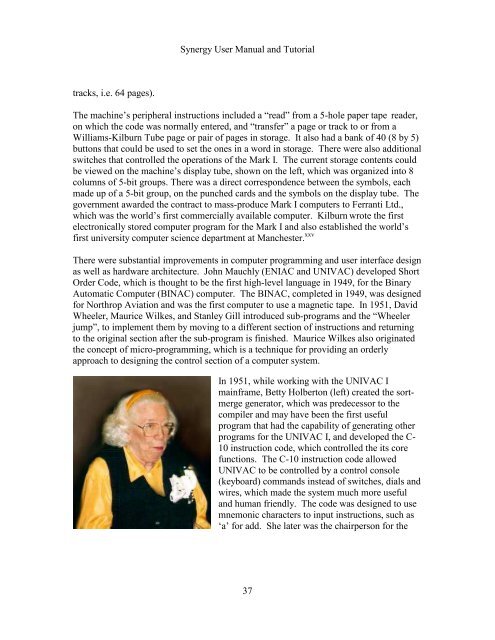Synergy User Manual and Tutorial. - THE CORE MEMORY
Synergy User Manual and Tutorial. - THE CORE MEMORY
Synergy User Manual and Tutorial. - THE CORE MEMORY
You also want an ePaper? Increase the reach of your titles
YUMPU automatically turns print PDFs into web optimized ePapers that Google loves.
<strong>Synergy</strong> <strong>User</strong> <strong>Manual</strong> <strong>and</strong> <strong>Tutorial</strong><br />
tracks, i.e. 64 pages).<br />
The machine’s peripheral instructions included a “read” from a 5-hole paper tape reader,<br />
on which the code was normally entered, <strong>and</strong> “transfer” a page or track to or from a<br />
Williams-Kilburn Tube page or pair of pages in storage. It also had a bank of 40 (8 by 5)<br />
buttons that could be used to set the ones in a word in storage. There were also additional<br />
switches that controlled the operations of the Mark I. The current storage contents could<br />
be viewed on the machine’s display tube, shown on the left, which was organized into 8<br />
columns of 5-bit groups. There was a direct correspondence between the symbols, each<br />
made up of a 5-bit group, on the punched cards <strong>and</strong> the symbols on the display tube. The<br />
government awarded the contract to mass-produce Mark I computers to Ferranti Ltd.,<br />
which was the world’s first commercially available computer. Kilburn wrote the first<br />
electronically stored computer program for the Mark I <strong>and</strong> also established the world’s<br />
first university computer science department at Manchester. xxv<br />
There were substantial improvements in computer programming <strong>and</strong> user interface design<br />
as well as hardware architecture. John Mauchly (ENIAC <strong>and</strong> UNIVAC) developed Short<br />
Order Code, which is thought to be the first high-level language in 1949, for the Binary<br />
Automatic Computer (BINAC) computer. The BINAC, completed in 1949, was designed<br />
for Northrop Aviation <strong>and</strong> was the first computer to use a magnetic tape. In 1951, David<br />
Wheeler, Maurice Wilkes, <strong>and</strong> Stanley Gill introduced sub-programs <strong>and</strong> the “Wheeler<br />
jump”, to implement them by moving to a different section of instructions <strong>and</strong> returning<br />
to the original section after the sub-program is finished. Maurice Wilkes also originated<br />
the concept of micro-programming, which is a technique for providing an orderly<br />
approach to designing the control section of a computer system.<br />
In 1951, while working with the UNIVAC I<br />
mainframe, Betty Holberton (left) created the sortmerge<br />
generator, which was predecessor to the<br />
compiler <strong>and</strong> may have been the first useful<br />
program that had the capability of generating other<br />
programs for the UNIVAC I, <strong>and</strong> developed the C-<br />
10 instruction code, which controlled the its core<br />
functions. The C-10 instruction code allowed<br />
UNIVAC to be controlled by a control console<br />
(keyboard) comm<strong>and</strong>s instead of switches, dials <strong>and</strong><br />
wires, which made the system much more useful<br />
<strong>and</strong> human friendly. The code was designed to use<br />
mnemonic characters to input instructions, such as<br />
‘a’ for add. She later was the chairperson for the<br />
37

















